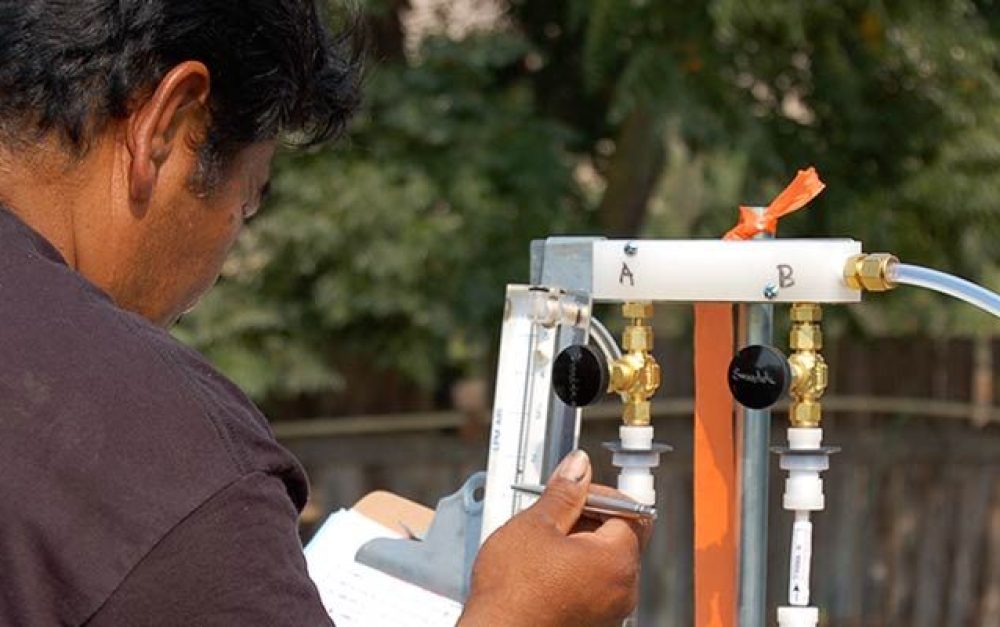Teachers, parents and other community members call on the State to revise its pesticide monitoring report to reflect the true health threats near schools and communities
Sacramento, CA – Late Friday, the California Department of Pesticide Regulation (DPR) released new data showing pesticides continue to be found in the air in rural communities, including near California schools. Although the department minimized the health threats in their report, a scientifically-rigorous assessment of the data shows the need for clear and comprehensive rules to protect schoolchildren from hazardous pesticide drift.
Three of the six monitoring sites are in close proximity to schools and have documented several different pesticides in the air, including cancer-causing fumigants 1,3-D (Telone), MITC and chloropicrin — the latter two of which also aggravate asthma. At the one school site where more pesticides were monitored (Shafter High), brain-harming organophosphate chlorpyrifos and the cancer-causing fungicide chlorothalonil were also detected.
Of particular concern is the fact that at four of the six monitoring sites — including the three located near schools — the carcinogenic fumigant pesticide 1,3-D was found above the cancer risk level of 0.1 parts per billion (ppb). This is above the target levels recommended by scientists at the Office of Environmental Health Hazard Assessment (OEHHA) to specifically protect children, who are particularly vulnerable to the harms of pesticide exposure. Additionally, DPR ignored OEHHA’s scientific guidance as well as recent science from UCLA, instead relaxing the cancer risk target level to 0.56 ppb. By doing so, DPR is now sanctioning up to four times as much exposure to carcinogenic 1,3-D as the department has allowed in the past, enabling the agency to claim that none of the pesticide air monitor detections of 1,3-D exceeded DPR’s levels of concern.
“Just this year UCLA scientists documented the increased cancer risk that 1,3-D can have when used in combination or consecutively with other fumigants, as it often is,” said Ohlone Elementary School teacher Karin Wanless. “UCLA scientists urged DPR to take into account these synergistic effects and adopt even more stringent regulatory protections. So what does DPR do? Lower the protections. That’s out of step with the department’s mission to protect human health and the environment through pesticide regulation.”
DPR’s treatment of 1,3-D in its air monitoring report is just one indication of how the agency’s summary of its air monitoring data continues to misinform and provide insufficient context for its findings. Community members near air monitoring sites are calling on CalEPA and DPR to rescind the recent relaxation of the 1,3-D cancer risk target level — and to revise the draft report to remove misleading conclusions that don’t reflect what’s really going on in communities.
This is particularly critical right now as DPR considers new draft regulations to address the use of hazardous agricultural pesticides near schools. In a 2014 report, the California Department of Public Health found heavy use of 144 pesticides of public health concern in close proximity to California schools. A few weeks ago, DPR unveiled its draft regulations, which parents, teachers, and advocates around the state argue are insufficient to protect schoolchildren’s health.
“Despite continued shortcomings in selection of some monitoring sites, pesticides have been regularly found in state air monitors, including those at schools, since the program began in 2011,” said Anne Katten, Pesticide and Worker Safety Project Director of the California Rural Legal Assistance Foundation. “The new results confirm yet again that cancer-causing and neurotoxic pesticides are drifting. These results should spur officials to take further action to protect schoolchildren from volatile and drift-prone pesticides. They should create stronger no-spray buffer zones around schools and adopt innovative agricultural practices to replace antiquated and hazardous pesticides.”
The legislature and governor recently authorized the addition of more air monitoring stations around California; in response, DPR plans to unveil much-needed revisions to its air monitoring network plan. Current air monitors are in Ripon, San Joaquin County; Salinas, Monterey County; Santa Maria, Santa Barbara County; Rio Mesa High School in Oxnard, Ventura County; Shafter High School in Shafter, Kern County; and Ohlone Elementary School in Watsonville, Santa Cruz County.
Contacts:
Paul Towers, PAN, 916-216-1082, ptowers@panna.org
Mark Weller, 831-325-1681, mark@pesticidereform.org







